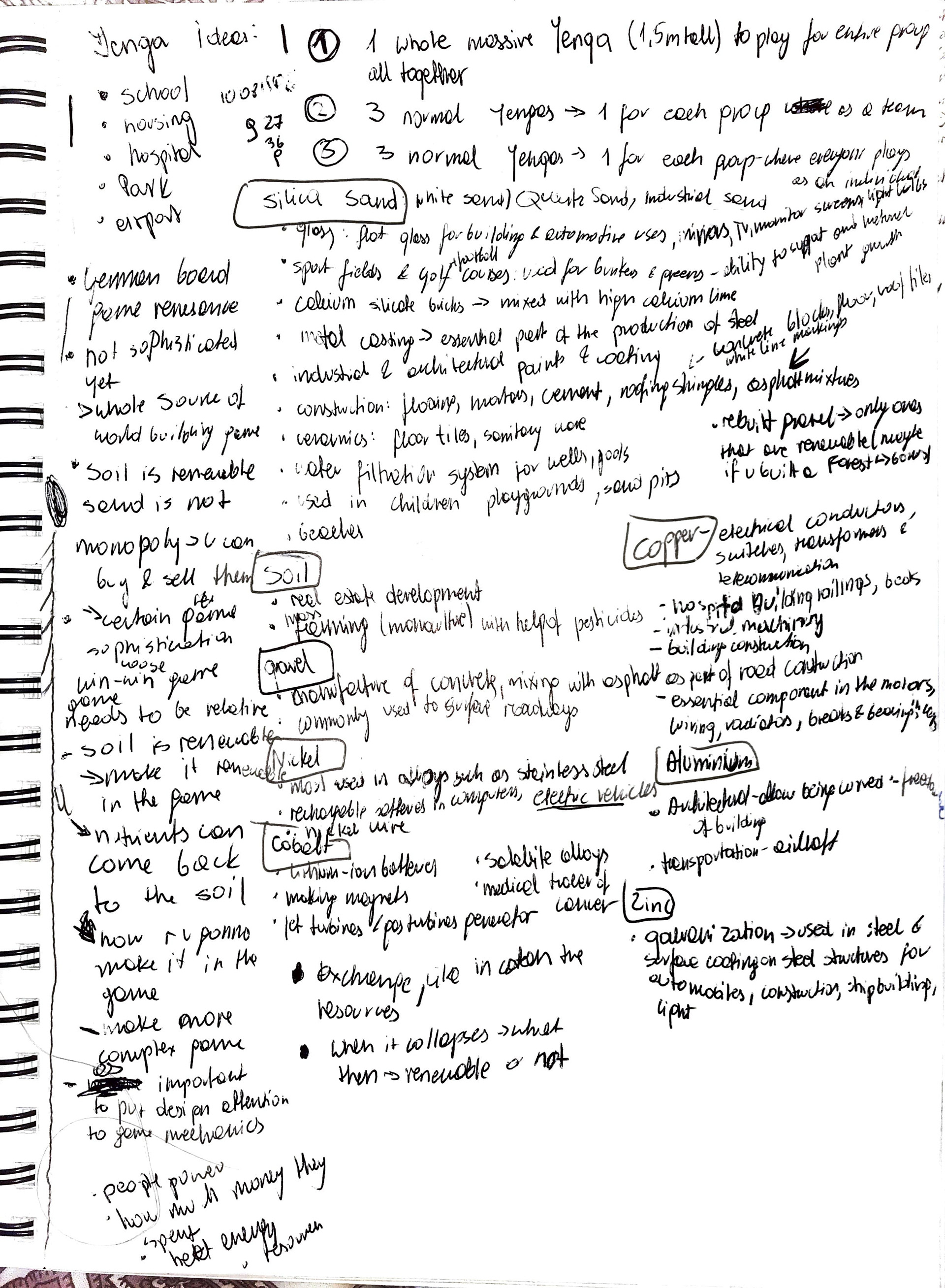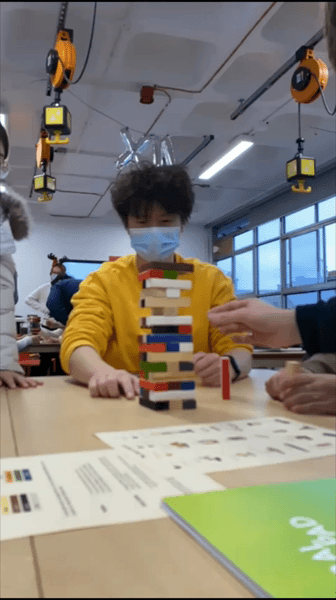4th December - 10th December
Group B: Sue An, Ula Rodakowska, Sanya Nayar, Kate Chernysheva
Group B: Sue An, Ula Rodakowska, Sanya Nayar, Kate Chernysheva
IDEATION & ITERATION
Our next question is: How do we create an experience that presents soil as a crucial yet valuable material?
To come up with a solution, we followed Mor’s advice she gave us at the presentation and used the Crazy Eight method. We each took a piece of paper, divided it into 8 sections and set a timer for 8 minutes.
Our Crazy Eight results. Screenshot taken by Kate.
As a result, we had lots to work with and began to discuss our ideas. In the next 10 minutes our rough concept was born.
Out thought process illustrated by Sue.
We decided to combine the Jenga tower game with a German game Renaissance or Catan. We knew the basics, but there were still small hiccups that we needed to find a solution to. What would happen to the pieces of Jenga pulled out of the tower? How to represent different materials in the tower? Do we make our own bricks out of resin and real materials? etc. To solve them, we each took the time on our own to think about it and see whether we could come up with some solutions.



Some sketches created during brainstorming. Sketches by Sue.



Sketch created during brainstorming. Made by Kate.
Sketches by Ula.
Jenga tower testing. Screenshot taken by Kate.
solutions & preparation
Shortly after our individual brainstorming, we finalised our game - extrACTION.
We decided that using actual materials to build 3 Jenga towers (One for each already existing team in the class) would take too much time, hence we simply decided to colour code the bricks.
We created a list of materials we wanted to be part of the tower and extrapolated what materials would be used for which menu item. Formed different shapes. Made some calculations to estimate how much of each material should be in a tower and created a menu.
A logo made by Sue.

Identifying materials we need - components of the tower. Screenshot taken by Kate.


Extrapolating what materials are needed for each construction included in the menu.

Calculating the percentage of materials needed for each tower of 48 bricks. Illustrated by Kate.




Painting the bricks. Pictures taken by Ula.





Brainstorming different shapes in order to make the game more playful and give more context. Photos taken by Ula.
FINAL IDEA: RULES OF THE GAME


Final set of rules and menu.
What we really wanted to see in this game was this realisation that they shouldn’t keep building until the tower falls. Because once it does, they can’t build any more. The winning team wouldn’t be the one that built the most, but the one that built mindfully bearing in mind their limited resources that are non-renewable.
PRESENTATION



Time-lapses from the groups' game process. Videos taken by Ula, Kate and Sue respectively.
FEEDBACK



Illustrations with the outcome created by Ula.
This presentation was a bit different as we played the game first and presented our ideas later on as we didn’t want to affect everyone’s thinking before the game. We received very positive feedback and the class thought that our response to the brief was very creative. There were some mistakes in our design that we should’ve paid more attention to. Two of our Jenga towers were the same, whereas the third one was slightly different. When painting the bricks, we forgot about it and painted bricks for some materials fully from one tower which caused some instability in our Jenga afterwards. Furthermore, what could have improved the game was if we used the resin like planned in the beginning. Nevertheless, We managed to create a meaningful experience that creates awareness of our planet’s precious resources.
BIBLIOGRAPHY
Kay, J. (2018). The Invasion of the German Board Games. [online] The Atlantic. Available at: https://www.theatlantic.com/business/archive/2018/01/german-board-games-catan/550826/ [Accessed 10 Jan. 2021].
Hampel, B. (2012). International board games become increasingly popular in US. [online] The Collegian. Available at: https://www.kstatecollegian.com/2012/11/09/international-board-games-become-increasingly-popular-in-us/ [Accessed 10 Jan. 2021].
Wired. (n.d.). Monopoly Killer: Perfect German Board Game Redefines Genre. [online] Available at: https://www.wired.com/2009/03/mf-settlers/ [Accessed 10 Jan. 2021].
Newark (2017). World’s largest vertical farm grows without soil, sunlight or water in Newark. [online] the Guardian. Available at: https://www.theguardian.com/environment/2016/aug/14/world-largest-vertical-farm-newark-green-revolution. [Accessed 10 Jan. 2021].
Axios (2018). The global cities with the most and least green space. [online] Axios. Available at: https://www.axios.com/the-cities-with-the-most-green-space-around-the-world-f92a437f-1de8-41e8-b534-6a9a00aa09d5.html. [Accessed 10 Jan. 2021].
Global News. (n.d.). The world is running out of sand — there’s even a violent black market for it. [online] Available at: https://globalnews.ca/news/4274233/world-running-out-of-sand-black-market/ [Accessed 10 Jan. 2021].
Beiser, V. (2019b). Why the world is running out of sand. [online] Bbc.com. Available at: https://www.bbc.com/future/article/20191108-why-the-world-is-running-out-of-sand. [Accessed 10 Jan. 2021].
www.nature.com. (n.d.). What Are Soils? | Learn Science at Scitable. [online] Available at: https://www.nature.com/scitable/knowledge/library/what-are-soils-67647639/#:~:text=Soil%20is%20a%20material%20composed. [Accessed 10 Jan. 2021].
Forest Research. (2018). Materials for soil formation. [online] Available at: https://www.forestresearch.gov.uk/tools-and-resources/urban-regeneration-and-greenspace-partnership/greenspace-in-practice/greenspace-establishment-practices/materials-for-soil-formation/ [Accessed 10 Jan. 2021].